HRM Challenges in Retail: Woolworths Case Study and SHRM Solutions
VerifiedAdded on 2023/04/04
|10
|2457
|109
Essay
AI Summary
This essay provides an in-depth analysis of human resource management (HRM) challenges encountered by Woolworths, a prominent Australian retailer. The study focuses on two critical areas: talent and workforce development, and compensation. The essay identifies specific issues such as inconsistencies in training programs, lack of management support, and low employee engagement, which contribute to high turnover rates. The analysis uses the Strategic Human Resource Management (SHRM) competency model to evaluate these challenges and proposes solutions. The essay examines the impact of employee engagement on organizational performance and the importance of recognition and reward systems. It highlights Woolworths' efforts in recruitment, employee learning, and career development programs. The essay concludes by emphasizing the need for organizations to invest in conditions that foster comprehensive employee engagement and development to sustain growth.
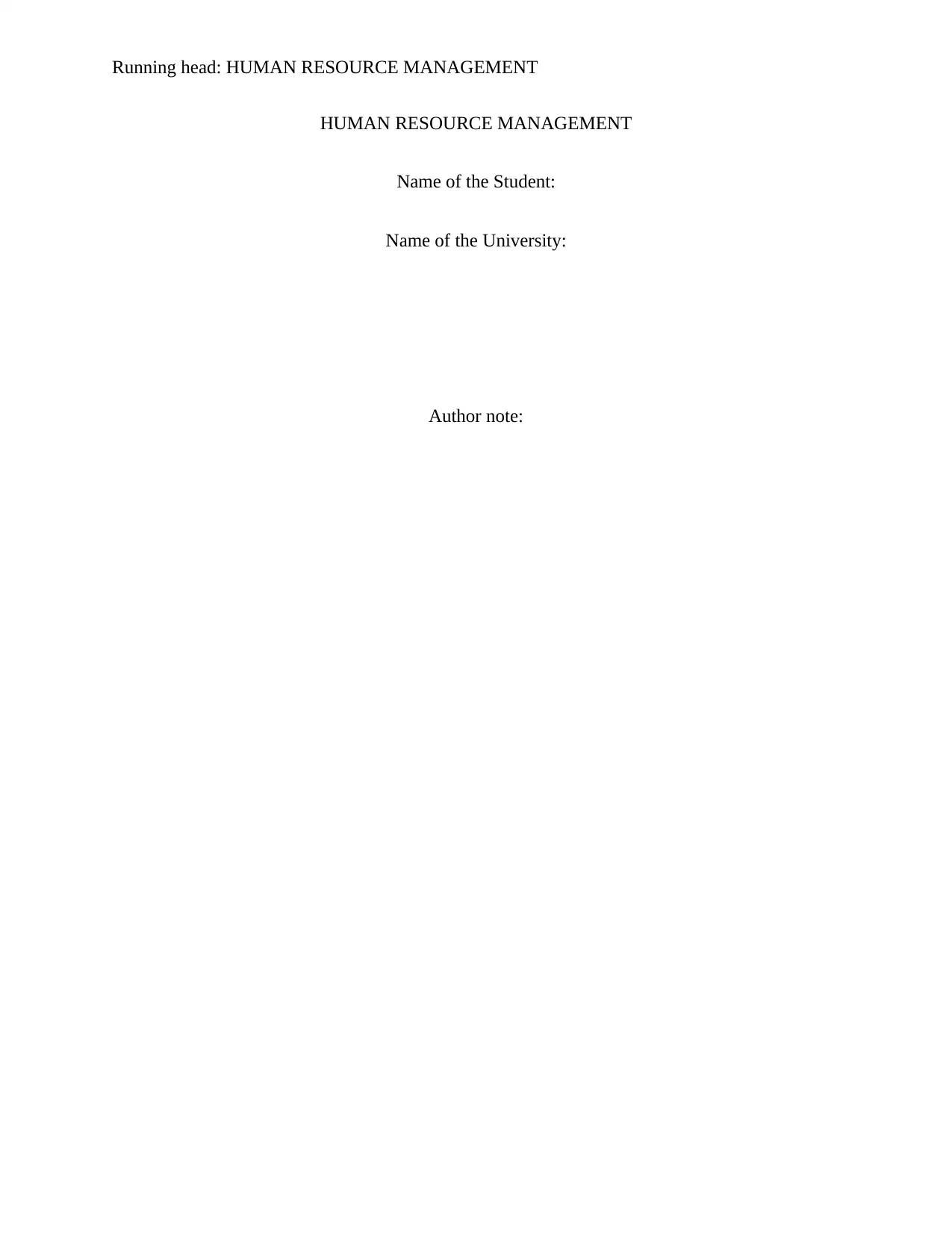
Running head: HUMAN RESOURCE MANAGEMENT
HUMAN RESOURCE MANAGEMENT
Name of the Student:
Name of the University:
Author note:
HUMAN RESOURCE MANAGEMENT
Name of the Student:
Name of the University:
Author note:
Paraphrase This Document
Need a fresh take? Get an instant paraphrase of this document with our AI Paraphraser
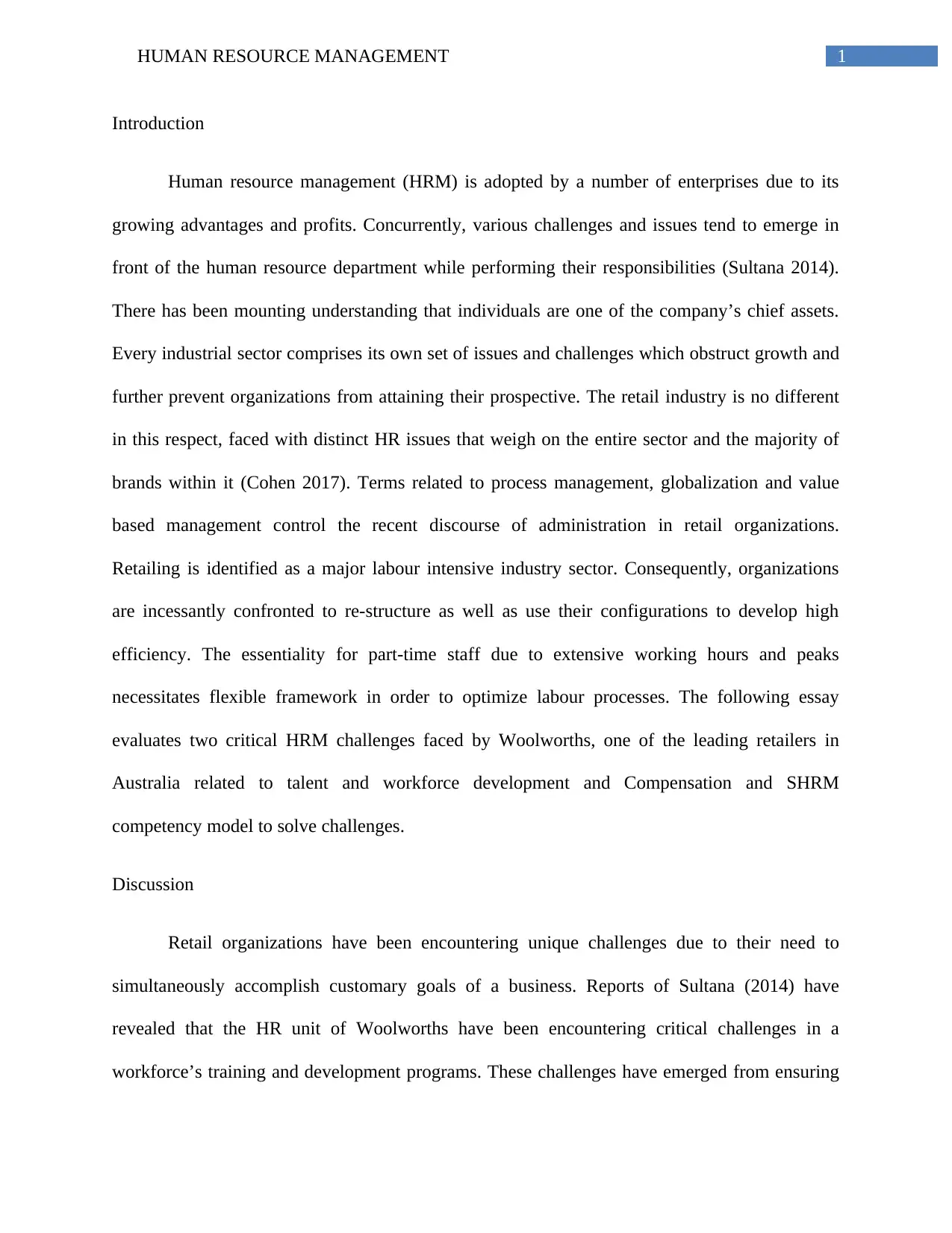
1HUMAN RESOURCE MANAGEMENT
Introduction
Human resource management (HRM) is adopted by a number of enterprises due to its
growing advantages and profits. Concurrently, various challenges and issues tend to emerge in
front of the human resource department while performing their responsibilities (Sultana 2014).
There has been mounting understanding that individuals are one of the company’s chief assets.
Every industrial sector comprises its own set of issues and challenges which obstruct growth and
further prevent organizations from attaining their prospective. The retail industry is no different
in this respect, faced with distinct HR issues that weigh on the entire sector and the majority of
brands within it (Cohen 2017). Terms related to process management, globalization and value
based management control the recent discourse of administration in retail organizations.
Retailing is identified as a major labour intensive industry sector. Consequently, organizations
are incessantly confronted to re-structure as well as use their configurations to develop high
efficiency. The essentiality for part-time staff due to extensive working hours and peaks
necessitates flexible framework in order to optimize labour processes. The following essay
evaluates two critical HRM challenges faced by Woolworths, one of the leading retailers in
Australia related to talent and workforce development and Compensation and SHRM
competency model to solve challenges.
Discussion
Retail organizations have been encountering unique challenges due to their need to
simultaneously accomplish customary goals of a business. Reports of Sultana (2014) have
revealed that the HR unit of Woolworths have been encountering critical challenges in a
workforce’s training and development programs. These challenges have emerged from ensuring
Introduction
Human resource management (HRM) is adopted by a number of enterprises due to its
growing advantages and profits. Concurrently, various challenges and issues tend to emerge in
front of the human resource department while performing their responsibilities (Sultana 2014).
There has been mounting understanding that individuals are one of the company’s chief assets.
Every industrial sector comprises its own set of issues and challenges which obstruct growth and
further prevent organizations from attaining their prospective. The retail industry is no different
in this respect, faced with distinct HR issues that weigh on the entire sector and the majority of
brands within it (Cohen 2017). Terms related to process management, globalization and value
based management control the recent discourse of administration in retail organizations.
Retailing is identified as a major labour intensive industry sector. Consequently, organizations
are incessantly confronted to re-structure as well as use their configurations to develop high
efficiency. The essentiality for part-time staff due to extensive working hours and peaks
necessitates flexible framework in order to optimize labour processes. The following essay
evaluates two critical HRM challenges faced by Woolworths, one of the leading retailers in
Australia related to talent and workforce development and Compensation and SHRM
competency model to solve challenges.
Discussion
Retail organizations have been encountering unique challenges due to their need to
simultaneously accomplish customary goals of a business. Reports of Sultana (2014) have
revealed that the HR unit of Woolworths have been encountering critical challenges in a
workforce’s training and development programs. These challenges have emerged from ensuring
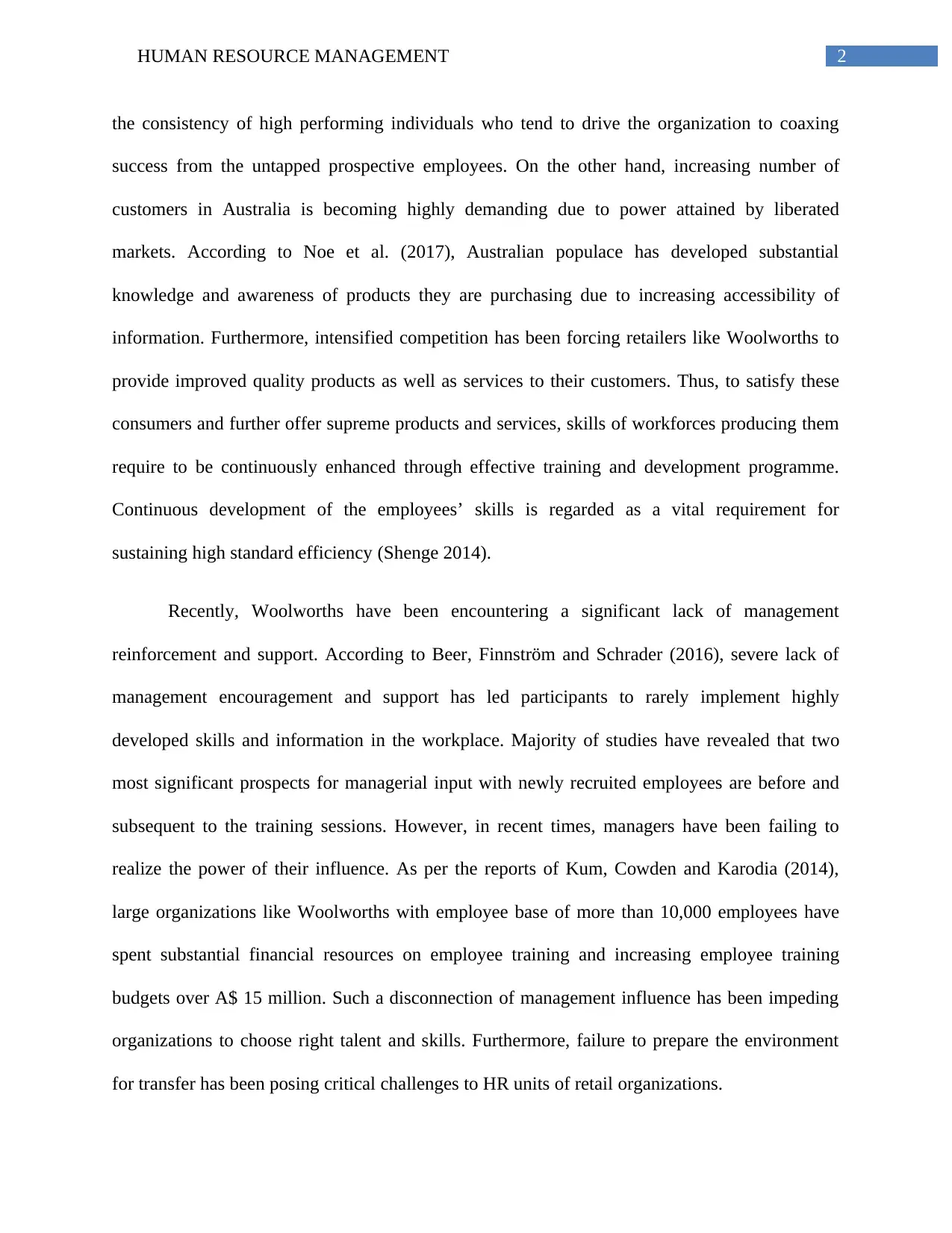
2HUMAN RESOURCE MANAGEMENT
the consistency of high performing individuals who tend to drive the organization to coaxing
success from the untapped prospective employees. On the other hand, increasing number of
customers in Australia is becoming highly demanding due to power attained by liberated
markets. According to Noe et al. (2017), Australian populace has developed substantial
knowledge and awareness of products they are purchasing due to increasing accessibility of
information. Furthermore, intensified competition has been forcing retailers like Woolworths to
provide improved quality products as well as services to their customers. Thus, to satisfy these
consumers and further offer supreme products and services, skills of workforces producing them
require to be continuously enhanced through effective training and development programme.
Continuous development of the employees’ skills is regarded as a vital requirement for
sustaining high standard efficiency (Shenge 2014).
Recently, Woolworths have been encountering a significant lack of management
reinforcement and support. According to Beer, Finnström and Schrader (2016), severe lack of
management encouragement and support has led participants to rarely implement highly
developed skills and information in the workplace. Majority of studies have revealed that two
most significant prospects for managerial input with newly recruited employees are before and
subsequent to the training sessions. However, in recent times, managers have been failing to
realize the power of their influence. As per the reports of Kum, Cowden and Karodia (2014),
large organizations like Woolworths with employee base of more than 10,000 employees have
spent substantial financial resources on employee training and increasing employee training
budgets over A$ 15 million. Such a disconnection of management influence has been impeding
organizations to choose right talent and skills. Furthermore, failure to prepare the environment
for transfer has been posing critical challenges to HR units of retail organizations.
the consistency of high performing individuals who tend to drive the organization to coaxing
success from the untapped prospective employees. On the other hand, increasing number of
customers in Australia is becoming highly demanding due to power attained by liberated
markets. According to Noe et al. (2017), Australian populace has developed substantial
knowledge and awareness of products they are purchasing due to increasing accessibility of
information. Furthermore, intensified competition has been forcing retailers like Woolworths to
provide improved quality products as well as services to their customers. Thus, to satisfy these
consumers and further offer supreme products and services, skills of workforces producing them
require to be continuously enhanced through effective training and development programme.
Continuous development of the employees’ skills is regarded as a vital requirement for
sustaining high standard efficiency (Shenge 2014).
Recently, Woolworths have been encountering a significant lack of management
reinforcement and support. According to Beer, Finnström and Schrader (2016), severe lack of
management encouragement and support has led participants to rarely implement highly
developed skills and information in the workplace. Majority of studies have revealed that two
most significant prospects for managerial input with newly recruited employees are before and
subsequent to the training sessions. However, in recent times, managers have been failing to
realize the power of their influence. As per the reports of Kum, Cowden and Karodia (2014),
large organizations like Woolworths with employee base of more than 10,000 employees have
spent substantial financial resources on employee training and increasing employee training
budgets over A$ 15 million. Such a disconnection of management influence has been impeding
organizations to choose right talent and skills. Furthermore, failure to prepare the environment
for transfer has been posing critical challenges to HR units of retail organizations.
⊘ This is a preview!⊘
Do you want full access?
Subscribe today to unlock all pages.

Trusted by 1+ million students worldwide
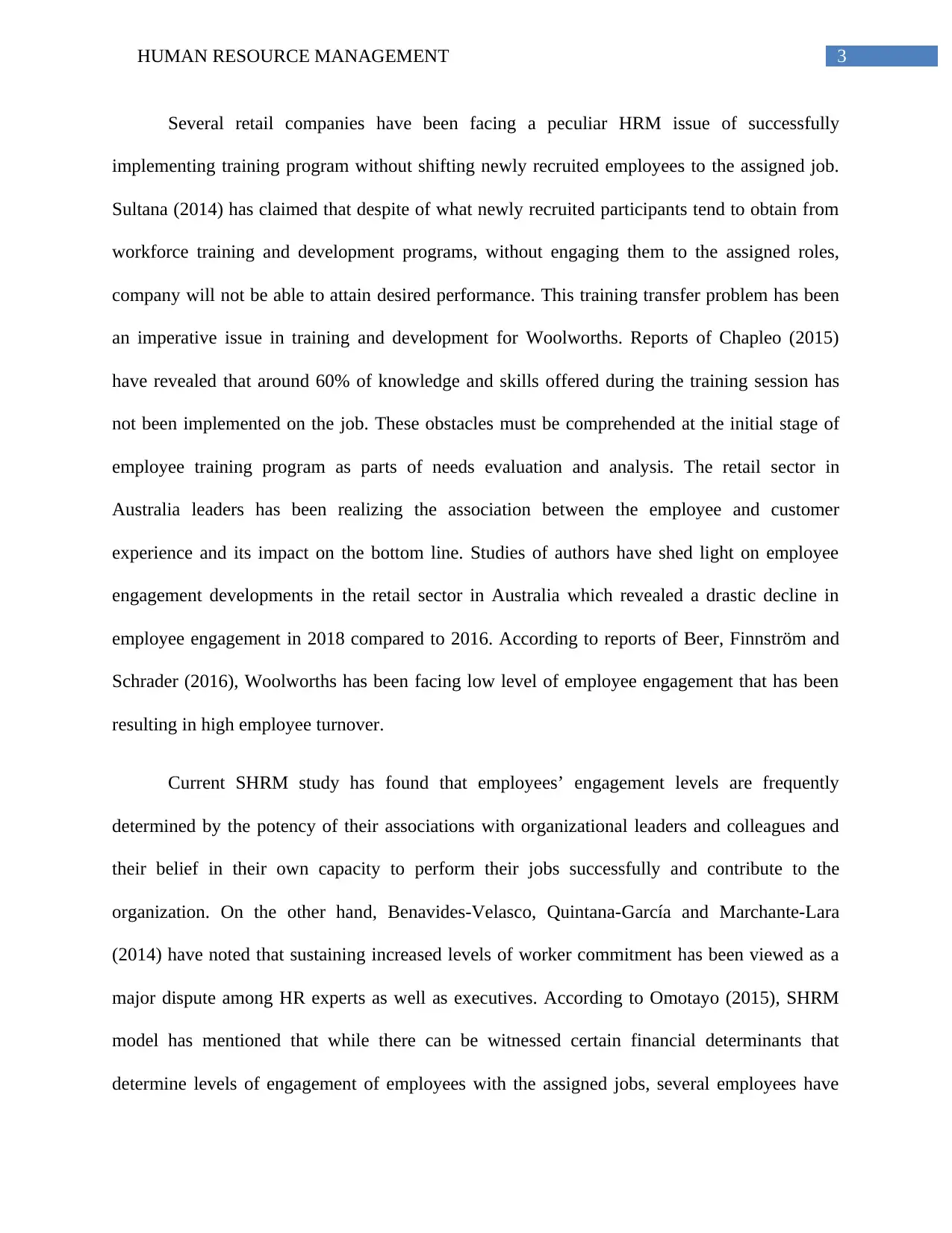
3HUMAN RESOURCE MANAGEMENT
Several retail companies have been facing a peculiar HRM issue of successfully
implementing training program without shifting newly recruited employees to the assigned job.
Sultana (2014) has claimed that despite of what newly recruited participants tend to obtain from
workforce training and development programs, without engaging them to the assigned roles,
company will not be able to attain desired performance. This training transfer problem has been
an imperative issue in training and development for Woolworths. Reports of Chapleo (2015)
have revealed that around 60% of knowledge and skills offered during the training session has
not been implemented on the job. These obstacles must be comprehended at the initial stage of
employee training program as parts of needs evaluation and analysis. The retail sector in
Australia leaders has been realizing the association between the employee and customer
experience and its impact on the bottom line. Studies of authors have shed light on employee
engagement developments in the retail sector in Australia which revealed a drastic decline in
employee engagement in 2018 compared to 2016. According to reports of Beer, Finnström and
Schrader (2016), Woolworths has been facing low level of employee engagement that has been
resulting in high employee turnover.
Current SHRM study has found that employees’ engagement levels are frequently
determined by the potency of their associations with organizational leaders and colleagues and
their belief in their own capacity to perform their jobs successfully and contribute to the
organization. On the other hand, Benavides-Velasco, Quintana-García and Marchante-Lara
(2014) have noted that sustaining increased levels of worker commitment has been viewed as a
major dispute among HR experts as well as executives. According to Omotayo (2015), SHRM
model has mentioned that while there can be witnessed certain financial determinants that
determine levels of engagement of employees with the assigned jobs, several employees have
Several retail companies have been facing a peculiar HRM issue of successfully
implementing training program without shifting newly recruited employees to the assigned job.
Sultana (2014) has claimed that despite of what newly recruited participants tend to obtain from
workforce training and development programs, without engaging them to the assigned roles,
company will not be able to attain desired performance. This training transfer problem has been
an imperative issue in training and development for Woolworths. Reports of Chapleo (2015)
have revealed that around 60% of knowledge and skills offered during the training session has
not been implemented on the job. These obstacles must be comprehended at the initial stage of
employee training program as parts of needs evaluation and analysis. The retail sector in
Australia leaders has been realizing the association between the employee and customer
experience and its impact on the bottom line. Studies of authors have shed light on employee
engagement developments in the retail sector in Australia which revealed a drastic decline in
employee engagement in 2018 compared to 2016. According to reports of Beer, Finnström and
Schrader (2016), Woolworths has been facing low level of employee engagement that has been
resulting in high employee turnover.
Current SHRM study has found that employees’ engagement levels are frequently
determined by the potency of their associations with organizational leaders and colleagues and
their belief in their own capacity to perform their jobs successfully and contribute to the
organization. On the other hand, Benavides-Velasco, Quintana-García and Marchante-Lara
(2014) have noted that sustaining increased levels of worker commitment has been viewed as a
major dispute among HR experts as well as executives. According to Omotayo (2015), SHRM
model has mentioned that while there can be witnessed certain financial determinants that
determine levels of engagement of employees with the assigned jobs, several employees have
Paraphrase This Document
Need a fresh take? Get an instant paraphrase of this document with our AI Paraphraser
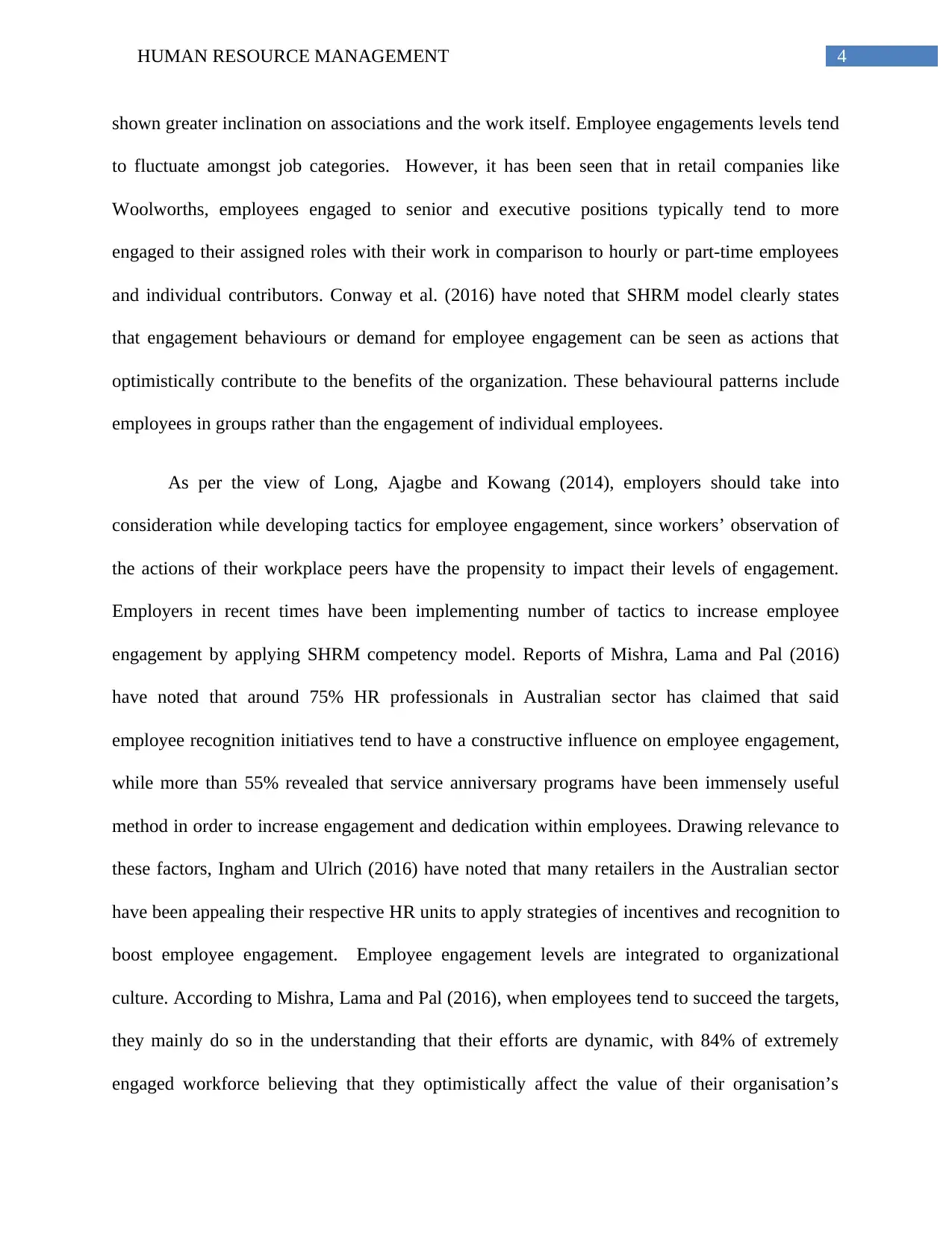
4HUMAN RESOURCE MANAGEMENT
shown greater inclination on associations and the work itself. Employee engagements levels tend
to fluctuate amongst job categories. However, it has been seen that in retail companies like
Woolworths, employees engaged to senior and executive positions typically tend to more
engaged to their assigned roles with their work in comparison to hourly or part-time employees
and individual contributors. Conway et al. (2016) have noted that SHRM model clearly states
that engagement behaviours or demand for employee engagement can be seen as actions that
optimistically contribute to the benefits of the organization. These behavioural patterns include
employees in groups rather than the engagement of individual employees.
As per the view of Long, Ajagbe and Kowang (2014), employers should take into
consideration while developing tactics for employee engagement, since workers’ observation of
the actions of their workplace peers have the propensity to impact their levels of engagement.
Employers in recent times have been implementing number of tactics to increase employee
engagement by applying SHRM competency model. Reports of Mishra, Lama and Pal (2016)
have noted that around 75% HR professionals in Australian sector has claimed that said
employee recognition initiatives tend to have a constructive influence on employee engagement,
while more than 55% revealed that service anniversary programs have been immensely useful
method in order to increase engagement and dedication within employees. Drawing relevance to
these factors, Ingham and Ulrich (2016) have noted that many retailers in the Australian sector
have been appealing their respective HR units to apply strategies of incentives and recognition to
boost employee engagement. Employee engagement levels are integrated to organizational
culture. According to Mishra, Lama and Pal (2016), when employees tend to succeed the targets,
they mainly do so in the understanding that their efforts are dynamic, with 84% of extremely
engaged workforce believing that they optimistically affect the value of their organisation’s
shown greater inclination on associations and the work itself. Employee engagements levels tend
to fluctuate amongst job categories. However, it has been seen that in retail companies like
Woolworths, employees engaged to senior and executive positions typically tend to more
engaged to their assigned roles with their work in comparison to hourly or part-time employees
and individual contributors. Conway et al. (2016) have noted that SHRM model clearly states
that engagement behaviours or demand for employee engagement can be seen as actions that
optimistically contribute to the benefits of the organization. These behavioural patterns include
employees in groups rather than the engagement of individual employees.
As per the view of Long, Ajagbe and Kowang (2014), employers should take into
consideration while developing tactics for employee engagement, since workers’ observation of
the actions of their workplace peers have the propensity to impact their levels of engagement.
Employers in recent times have been implementing number of tactics to increase employee
engagement by applying SHRM competency model. Reports of Mishra, Lama and Pal (2016)
have noted that around 75% HR professionals in Australian sector has claimed that said
employee recognition initiatives tend to have a constructive influence on employee engagement,
while more than 55% revealed that service anniversary programs have been immensely useful
method in order to increase engagement and dedication within employees. Drawing relevance to
these factors, Ingham and Ulrich (2016) have noted that many retailers in the Australian sector
have been appealing their respective HR units to apply strategies of incentives and recognition to
boost employee engagement. Employee engagement levels are integrated to organizational
culture. According to Mishra, Lama and Pal (2016), when employees tend to succeed the targets,
they mainly do so in the understanding that their efforts are dynamic, with 84% of extremely
engaged workforce believing that they optimistically affect the value of their organisation’s
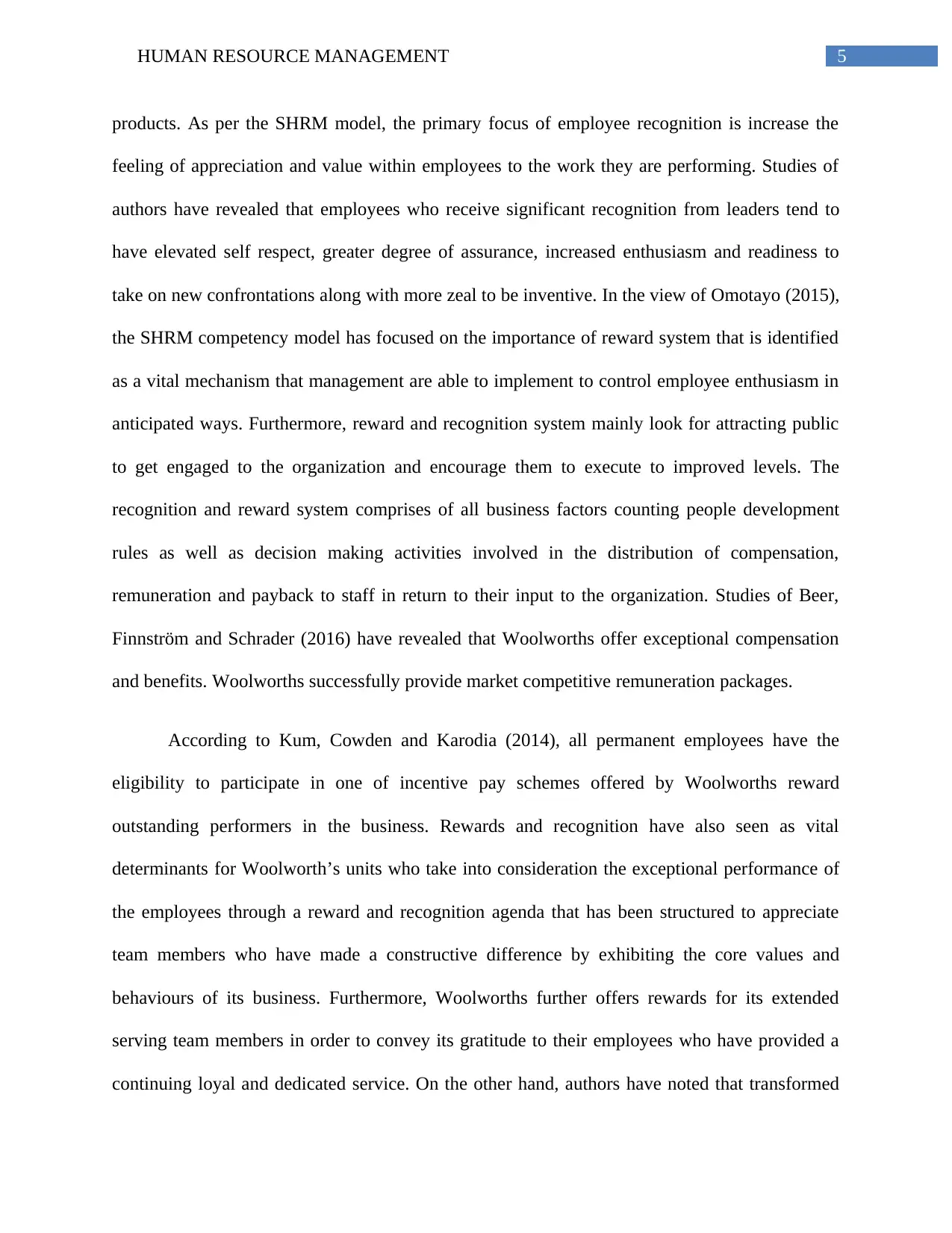
5HUMAN RESOURCE MANAGEMENT
products. As per the SHRM model, the primary focus of employee recognition is increase the
feeling of appreciation and value within employees to the work they are performing. Studies of
authors have revealed that employees who receive significant recognition from leaders tend to
have elevated self respect, greater degree of assurance, increased enthusiasm and readiness to
take on new confrontations along with more zeal to be inventive. In the view of Omotayo (2015),
the SHRM competency model has focused on the importance of reward system that is identified
as a vital mechanism that management are able to implement to control employee enthusiasm in
anticipated ways. Furthermore, reward and recognition system mainly look for attracting public
to get engaged to the organization and encourage them to execute to improved levels. The
recognition and reward system comprises of all business factors counting people development
rules as well as decision making activities involved in the distribution of compensation,
remuneration and payback to staff in return to their input to the organization. Studies of Beer,
Finnström and Schrader (2016) have revealed that Woolworths offer exceptional compensation
and benefits. Woolworths successfully provide market competitive remuneration packages.
According to Kum, Cowden and Karodia (2014), all permanent employees have the
eligibility to participate in one of incentive pay schemes offered by Woolworths reward
outstanding performers in the business. Rewards and recognition have also seen as vital
determinants for Woolworth’s units who take into consideration the exceptional performance of
the employees through a reward and recognition agenda that has been structured to appreciate
team members who have made a constructive difference by exhibiting the core values and
behaviours of its business. Furthermore, Woolworths further offers rewards for its extended
serving team members in order to convey its gratitude to their employees who have provided a
continuing loyal and dedicated service. On the other hand, authors have noted that transformed
products. As per the SHRM model, the primary focus of employee recognition is increase the
feeling of appreciation and value within employees to the work they are performing. Studies of
authors have revealed that employees who receive significant recognition from leaders tend to
have elevated self respect, greater degree of assurance, increased enthusiasm and readiness to
take on new confrontations along with more zeal to be inventive. In the view of Omotayo (2015),
the SHRM competency model has focused on the importance of reward system that is identified
as a vital mechanism that management are able to implement to control employee enthusiasm in
anticipated ways. Furthermore, reward and recognition system mainly look for attracting public
to get engaged to the organization and encourage them to execute to improved levels. The
recognition and reward system comprises of all business factors counting people development
rules as well as decision making activities involved in the distribution of compensation,
remuneration and payback to staff in return to their input to the organization. Studies of Beer,
Finnström and Schrader (2016) have revealed that Woolworths offer exceptional compensation
and benefits. Woolworths successfully provide market competitive remuneration packages.
According to Kum, Cowden and Karodia (2014), all permanent employees have the
eligibility to participate in one of incentive pay schemes offered by Woolworths reward
outstanding performers in the business. Rewards and recognition have also seen as vital
determinants for Woolworth’s units who take into consideration the exceptional performance of
the employees through a reward and recognition agenda that has been structured to appreciate
team members who have made a constructive difference by exhibiting the core values and
behaviours of its business. Furthermore, Woolworths further offers rewards for its extended
serving team members in order to convey its gratitude to their employees who have provided a
continuing loyal and dedicated service. On the other hand, authors have noted that transformed
⊘ This is a preview!⊘
Do you want full access?
Subscribe today to unlock all pages.

Trusted by 1+ million students worldwide
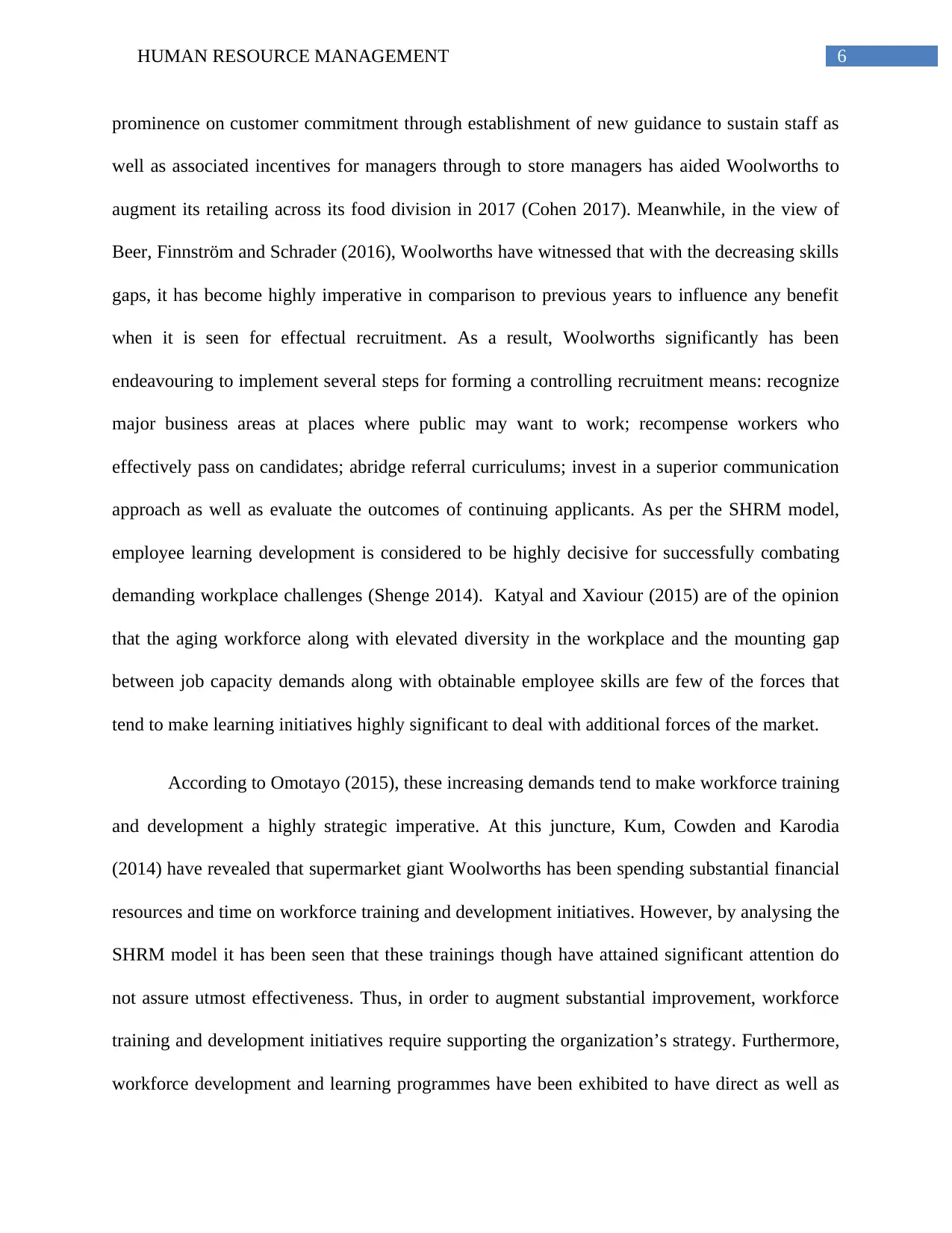
6HUMAN RESOURCE MANAGEMENT
prominence on customer commitment through establishment of new guidance to sustain staff as
well as associated incentives for managers through to store managers has aided Woolworths to
augment its retailing across its food division in 2017 (Cohen 2017). Meanwhile, in the view of
Beer, Finnström and Schrader (2016), Woolworths have witnessed that with the decreasing skills
gaps, it has become highly imperative in comparison to previous years to influence any benefit
when it is seen for effectual recruitment. As a result, Woolworths significantly has been
endeavouring to implement several steps for forming a controlling recruitment means: recognize
major business areas at places where public may want to work; recompense workers who
effectively pass on candidates; abridge referral curriculums; invest in a superior communication
approach as well as evaluate the outcomes of continuing applicants. As per the SHRM model,
employee learning development is considered to be highly decisive for successfully combating
demanding workplace challenges (Shenge 2014). Katyal and Xaviour (2015) are of the opinion
that the aging workforce along with elevated diversity in the workplace and the mounting gap
between job capacity demands along with obtainable employee skills are few of the forces that
tend to make learning initiatives highly significant to deal with additional forces of the market.
According to Omotayo (2015), these increasing demands tend to make workforce training
and development a highly strategic imperative. At this juncture, Kum, Cowden and Karodia
(2014) have revealed that supermarket giant Woolworths has been spending substantial financial
resources and time on workforce training and development initiatives. However, by analysing the
SHRM model it has been seen that these trainings though have attained significant attention do
not assure utmost effectiveness. Thus, in order to augment substantial improvement, workforce
training and development initiatives require supporting the organization’s strategy. Furthermore,
workforce development and learning programmes have been exhibited to have direct as well as
prominence on customer commitment through establishment of new guidance to sustain staff as
well as associated incentives for managers through to store managers has aided Woolworths to
augment its retailing across its food division in 2017 (Cohen 2017). Meanwhile, in the view of
Beer, Finnström and Schrader (2016), Woolworths have witnessed that with the decreasing skills
gaps, it has become highly imperative in comparison to previous years to influence any benefit
when it is seen for effectual recruitment. As a result, Woolworths significantly has been
endeavouring to implement several steps for forming a controlling recruitment means: recognize
major business areas at places where public may want to work; recompense workers who
effectively pass on candidates; abridge referral curriculums; invest in a superior communication
approach as well as evaluate the outcomes of continuing applicants. As per the SHRM model,
employee learning development is considered to be highly decisive for successfully combating
demanding workplace challenges (Shenge 2014). Katyal and Xaviour (2015) are of the opinion
that the aging workforce along with elevated diversity in the workplace and the mounting gap
between job capacity demands along with obtainable employee skills are few of the forces that
tend to make learning initiatives highly significant to deal with additional forces of the market.
According to Omotayo (2015), these increasing demands tend to make workforce training
and development a highly strategic imperative. At this juncture, Kum, Cowden and Karodia
(2014) have revealed that supermarket giant Woolworths has been spending substantial financial
resources and time on workforce training and development initiatives. However, by analysing the
SHRM model it has been seen that these trainings though have attained significant attention do
not assure utmost effectiveness. Thus, in order to augment substantial improvement, workforce
training and development initiatives require supporting the organization’s strategy. Furthermore,
workforce development and learning programmes have been exhibited to have direct as well as
Paraphrase This Document
Need a fresh take? Get an instant paraphrase of this document with our AI Paraphraser
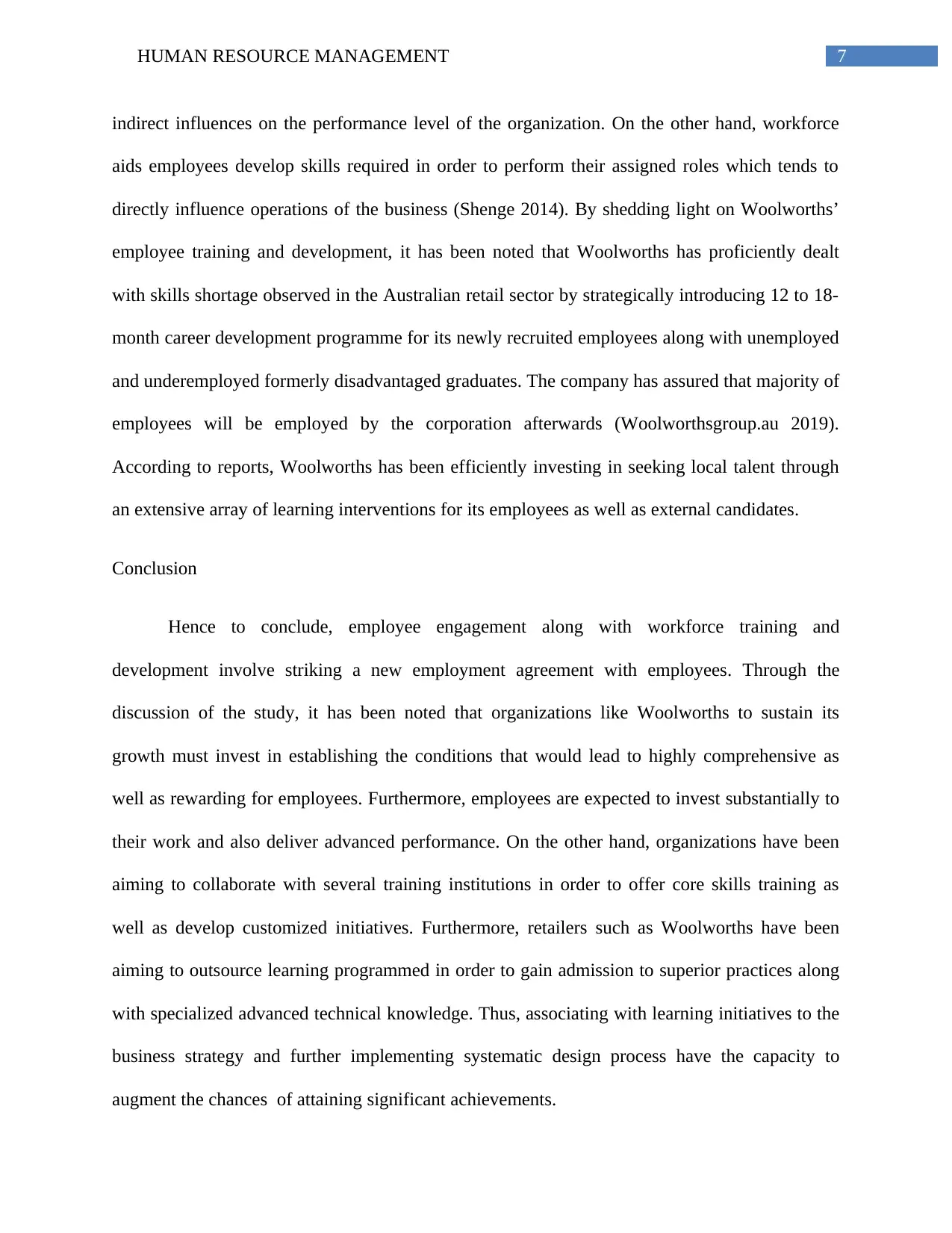
7HUMAN RESOURCE MANAGEMENT
indirect influences on the performance level of the organization. On the other hand, workforce
aids employees develop skills required in order to perform their assigned roles which tends to
directly influence operations of the business (Shenge 2014). By shedding light on Woolworths’
employee training and development, it has been noted that Woolworths has proficiently dealt
with skills shortage observed in the Australian retail sector by strategically introducing 12 to 18-
month career development programme for its newly recruited employees along with unemployed
and underemployed formerly disadvantaged graduates. The company has assured that majority of
employees will be employed by the corporation afterwards (Woolworthsgroup.au 2019).
According to reports, Woolworths has been efficiently investing in seeking local talent through
an extensive array of learning interventions for its employees as well as external candidates.
Conclusion
Hence to conclude, employee engagement along with workforce training and
development involve striking a new employment agreement with employees. Through the
discussion of the study, it has been noted that organizations like Woolworths to sustain its
growth must invest in establishing the conditions that would lead to highly comprehensive as
well as rewarding for employees. Furthermore, employees are expected to invest substantially to
their work and also deliver advanced performance. On the other hand, organizations have been
aiming to collaborate with several training institutions in order to offer core skills training as
well as develop customized initiatives. Furthermore, retailers such as Woolworths have been
aiming to outsource learning programmed in order to gain admission to superior practices along
with specialized advanced technical knowledge. Thus, associating with learning initiatives to the
business strategy and further implementing systematic design process have the capacity to
augment the chances of attaining significant achievements.
indirect influences on the performance level of the organization. On the other hand, workforce
aids employees develop skills required in order to perform their assigned roles which tends to
directly influence operations of the business (Shenge 2014). By shedding light on Woolworths’
employee training and development, it has been noted that Woolworths has proficiently dealt
with skills shortage observed in the Australian retail sector by strategically introducing 12 to 18-
month career development programme for its newly recruited employees along with unemployed
and underemployed formerly disadvantaged graduates. The company has assured that majority of
employees will be employed by the corporation afterwards (Woolworthsgroup.au 2019).
According to reports, Woolworths has been efficiently investing in seeking local talent through
an extensive array of learning interventions for its employees as well as external candidates.
Conclusion
Hence to conclude, employee engagement along with workforce training and
development involve striking a new employment agreement with employees. Through the
discussion of the study, it has been noted that organizations like Woolworths to sustain its
growth must invest in establishing the conditions that would lead to highly comprehensive as
well as rewarding for employees. Furthermore, employees are expected to invest substantially to
their work and also deliver advanced performance. On the other hand, organizations have been
aiming to collaborate with several training institutions in order to offer core skills training as
well as develop customized initiatives. Furthermore, retailers such as Woolworths have been
aiming to outsource learning programmed in order to gain admission to superior practices along
with specialized advanced technical knowledge. Thus, associating with learning initiatives to the
business strategy and further implementing systematic design process have the capacity to
augment the chances of attaining significant achievements.
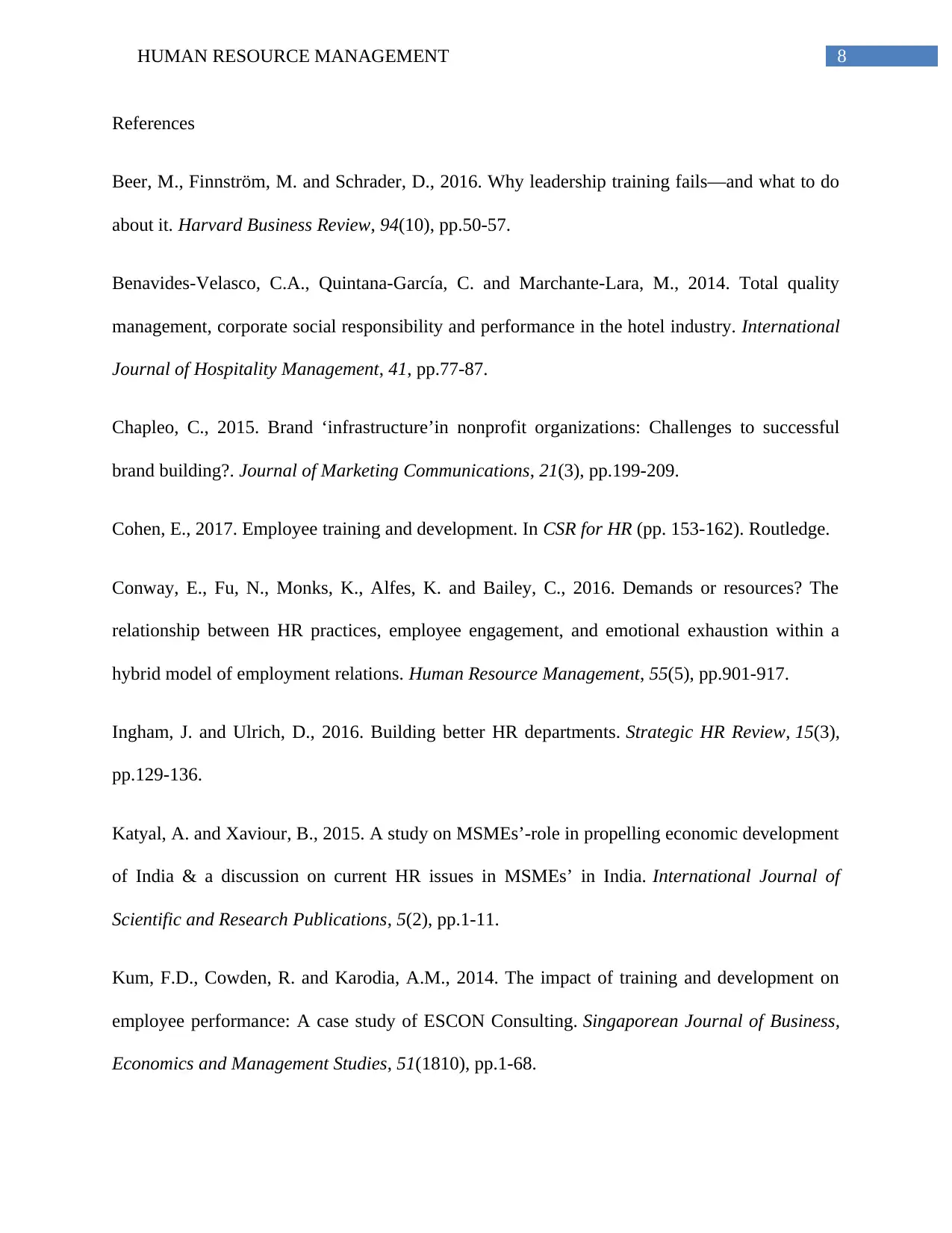
8HUMAN RESOURCE MANAGEMENT
References
Beer, M., Finnström, M. and Schrader, D., 2016. Why leadership training fails—and what to do
about it. Harvard Business Review, 94(10), pp.50-57.
Benavides-Velasco, C.A., Quintana-García, C. and Marchante-Lara, M., 2014. Total quality
management, corporate social responsibility and performance in the hotel industry. International
Journal of Hospitality Management, 41, pp.77-87.
Chapleo, C., 2015. Brand ‘infrastructure’in nonprofit organizations: Challenges to successful
brand building?. Journal of Marketing Communications, 21(3), pp.199-209.
Cohen, E., 2017. Employee training and development. In CSR for HR (pp. 153-162). Routledge.
Conway, E., Fu, N., Monks, K., Alfes, K. and Bailey, C., 2016. Demands or resources? The
relationship between HR practices, employee engagement, and emotional exhaustion within a
hybrid model of employment relations. Human Resource Management, 55(5), pp.901-917.
Ingham, J. and Ulrich, D., 2016. Building better HR departments. Strategic HR Review, 15(3),
pp.129-136.
Katyal, A. and Xaviour, B., 2015. A study on MSMEs’-role in propelling economic development
of India & a discussion on current HR issues in MSMEs’ in India. International Journal of
Scientific and Research Publications, 5(2), pp.1-11.
Kum, F.D., Cowden, R. and Karodia, A.M., 2014. The impact of training and development on
employee performance: A case study of ESCON Consulting. Singaporean Journal of Business,
Economics and Management Studies, 51(1810), pp.1-68.
References
Beer, M., Finnström, M. and Schrader, D., 2016. Why leadership training fails—and what to do
about it. Harvard Business Review, 94(10), pp.50-57.
Benavides-Velasco, C.A., Quintana-García, C. and Marchante-Lara, M., 2014. Total quality
management, corporate social responsibility and performance in the hotel industry. International
Journal of Hospitality Management, 41, pp.77-87.
Chapleo, C., 2015. Brand ‘infrastructure’in nonprofit organizations: Challenges to successful
brand building?. Journal of Marketing Communications, 21(3), pp.199-209.
Cohen, E., 2017. Employee training and development. In CSR for HR (pp. 153-162). Routledge.
Conway, E., Fu, N., Monks, K., Alfes, K. and Bailey, C., 2016. Demands or resources? The
relationship between HR practices, employee engagement, and emotional exhaustion within a
hybrid model of employment relations. Human Resource Management, 55(5), pp.901-917.
Ingham, J. and Ulrich, D., 2016. Building better HR departments. Strategic HR Review, 15(3),
pp.129-136.
Katyal, A. and Xaviour, B., 2015. A study on MSMEs’-role in propelling economic development
of India & a discussion on current HR issues in MSMEs’ in India. International Journal of
Scientific and Research Publications, 5(2), pp.1-11.
Kum, F.D., Cowden, R. and Karodia, A.M., 2014. The impact of training and development on
employee performance: A case study of ESCON Consulting. Singaporean Journal of Business,
Economics and Management Studies, 51(1810), pp.1-68.
⊘ This is a preview!⊘
Do you want full access?
Subscribe today to unlock all pages.

Trusted by 1+ million students worldwide
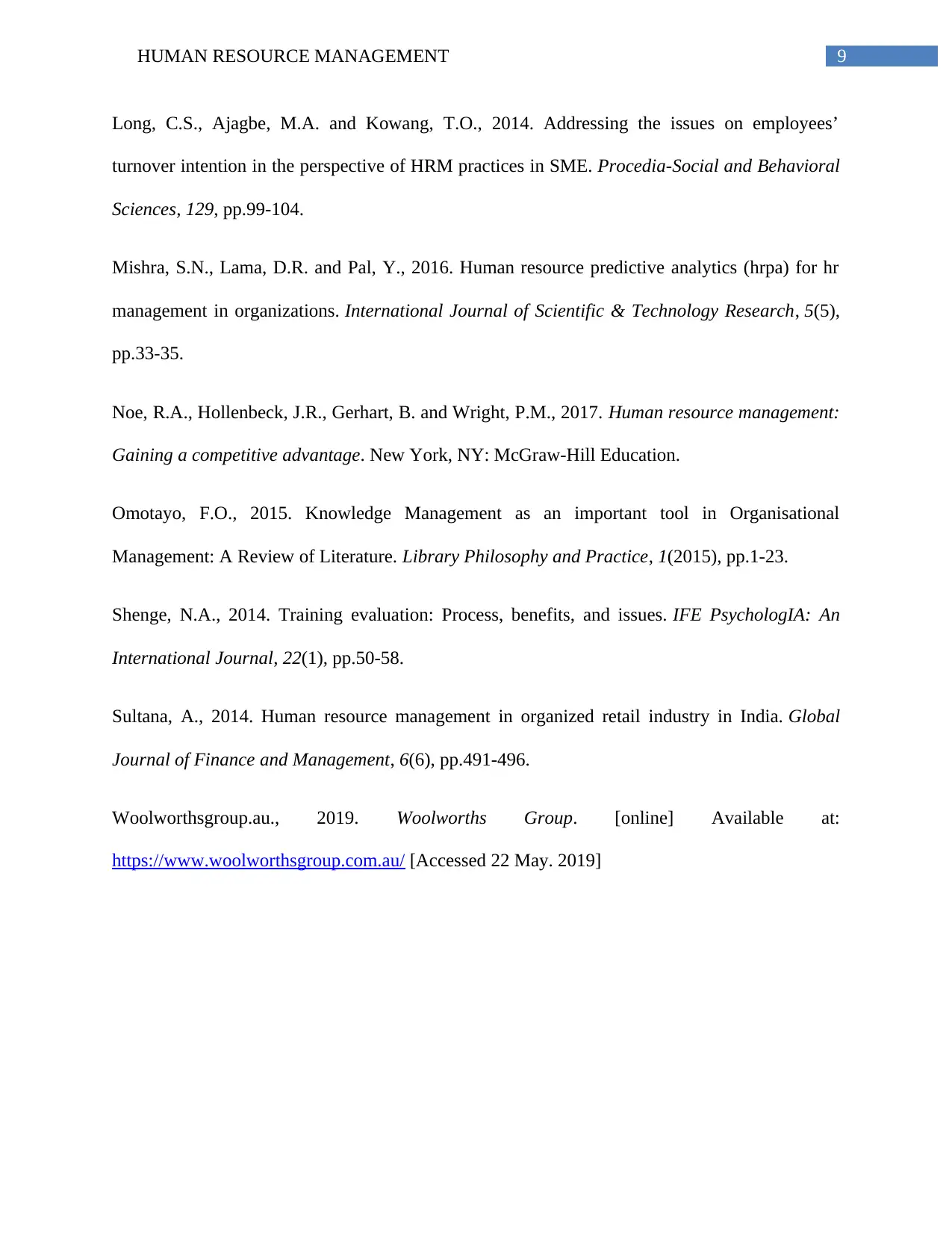
9HUMAN RESOURCE MANAGEMENT
Long, C.S., Ajagbe, M.A. and Kowang, T.O., 2014. Addressing the issues on employees’
turnover intention in the perspective of HRM practices in SME. Procedia-Social and Behavioral
Sciences, 129, pp.99-104.
Mishra, S.N., Lama, D.R. and Pal, Y., 2016. Human resource predictive analytics (hrpa) for hr
management in organizations. International Journal of Scientific & Technology Research, 5(5),
pp.33-35.
Noe, R.A., Hollenbeck, J.R., Gerhart, B. and Wright, P.M., 2017. Human resource management:
Gaining a competitive advantage. New York, NY: McGraw-Hill Education.
Omotayo, F.O., 2015. Knowledge Management as an important tool in Organisational
Management: A Review of Literature. Library Philosophy and Practice, 1(2015), pp.1-23.
Shenge, N.A., 2014. Training evaluation: Process, benefits, and issues. IFE PsychologIA: An
International Journal, 22(1), pp.50-58.
Sultana, A., 2014. Human resource management in organized retail industry in India. Global
Journal of Finance and Management, 6(6), pp.491-496.
Woolworthsgroup.au., 2019. Woolworths Group. [online] Available at:
https://www.woolworthsgroup.com.au/ [Accessed 22 May. 2019]
Long, C.S., Ajagbe, M.A. and Kowang, T.O., 2014. Addressing the issues on employees’
turnover intention in the perspective of HRM practices in SME. Procedia-Social and Behavioral
Sciences, 129, pp.99-104.
Mishra, S.N., Lama, D.R. and Pal, Y., 2016. Human resource predictive analytics (hrpa) for hr
management in organizations. International Journal of Scientific & Technology Research, 5(5),
pp.33-35.
Noe, R.A., Hollenbeck, J.R., Gerhart, B. and Wright, P.M., 2017. Human resource management:
Gaining a competitive advantage. New York, NY: McGraw-Hill Education.
Omotayo, F.O., 2015. Knowledge Management as an important tool in Organisational
Management: A Review of Literature. Library Philosophy and Practice, 1(2015), pp.1-23.
Shenge, N.A., 2014. Training evaluation: Process, benefits, and issues. IFE PsychologIA: An
International Journal, 22(1), pp.50-58.
Sultana, A., 2014. Human resource management in organized retail industry in India. Global
Journal of Finance and Management, 6(6), pp.491-496.
Woolworthsgroup.au., 2019. Woolworths Group. [online] Available at:
https://www.woolworthsgroup.com.au/ [Accessed 22 May. 2019]
1 out of 10
Related Documents
Your All-in-One AI-Powered Toolkit for Academic Success.
+13062052269
info@desklib.com
Available 24*7 on WhatsApp / Email
![[object Object]](/_next/static/media/star-bottom.7253800d.svg)
Unlock your academic potential
Copyright © 2020–2025 A2Z Services. All Rights Reserved. Developed and managed by ZUCOL.





